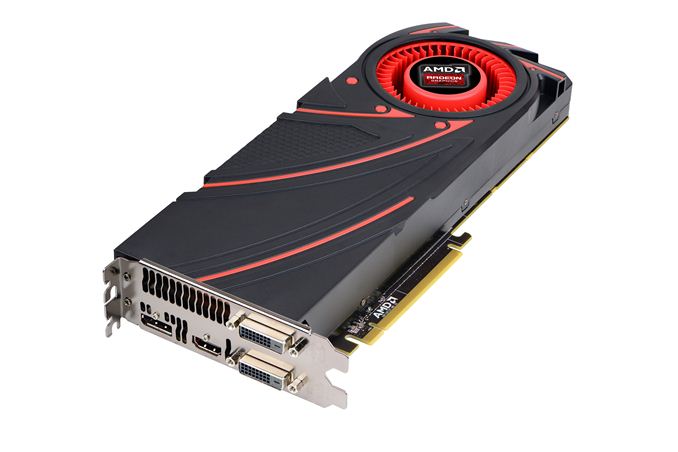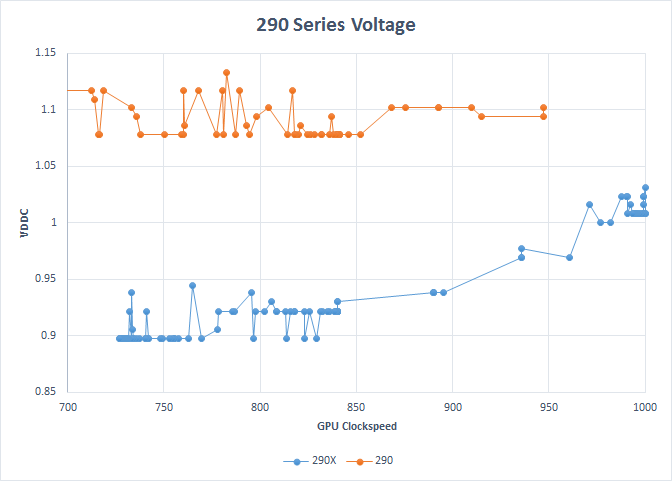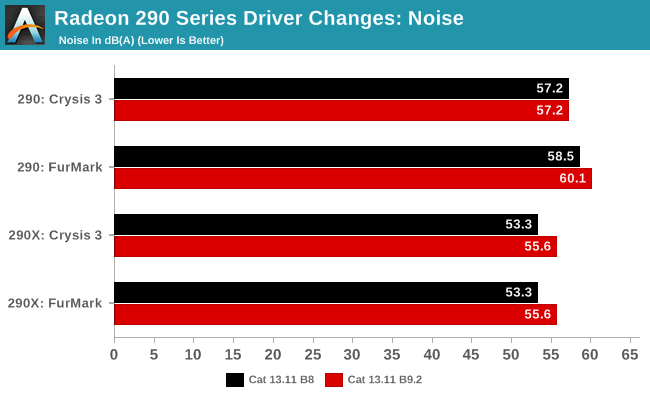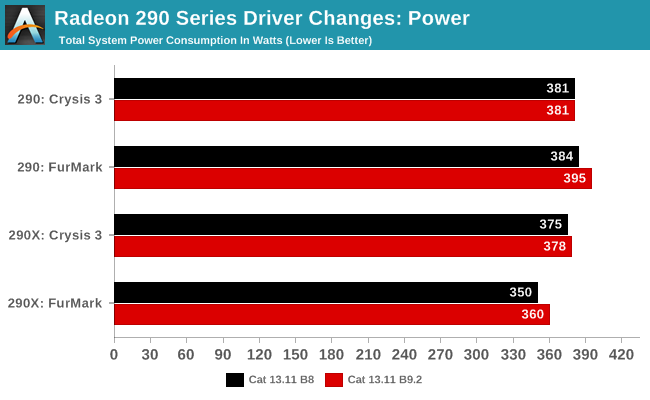AMD Changes 290 Series Fan Algorithms & About That 290 Conclusion
by Ryan Smith on November 9, 2013 3:48 PM EST- Posted in
- GPUs
- AMD
- Radeon
- Radeon 200

In a busy week that’s going to end up being just a bit busier, AMD has pushed out another Catalyst driver update specifically targeted at the new Radeon R9 290 series, Catalyst 13.11 Beta9.2. This release is especially notable because it resolves some outstanding issues with the hardware that the hardware press has covered in depth this week opposite the 290 launch, and because it is making low level operational changes that will have a direct impact on the power, noise, and performance characteristics of the 290 series.
First off, let’s talk about what AMD has done with their drivers. Citing an issue with variability in the fan speeds on 290 series cards, AMD has changed the algorithms for how their drivers handle the fan speeds on 290 series cards, essentially overriding the BIOS defaults with new values. This is similar to how AMD deployed their specification changes for the 290 ahead of its launch – adjusting it from 40% to 47% as the default maximum fan speed – but AMD has also used their driver update to change how they’re defining and controlling fan speeds.
Rather than controlling fan speed based on percentages, which are really measuring fan speed as the duty cycle of the fan’s motor on a relative basis, AMD has switched to controlling fan speeds on an absolute basis, using the measured RPM of the fan as their metric of absolute fan speed. This goes back to AMD’s concern over variance, as there is going to be some variance – and apparently too much variance – from fan motor to fan motor in how fast it can go, and consequently just what a specific duty cycle represents on a relative basis. Consequently by switching to measuring fan speed on an absolute basis there will definitely be less variation. as AMD is now controlling fan speeds by the very same metric they use to define that variation (RPM).
For the release of this driver, this is what AMD specifically had to say.
We’ve identified that there’s variability in fan speeds across AMD R9 290 series boards. This variability in fan speed translates into variability of the cooling capacity of the fan-sink.
The flexibility of AMD PowerTune technology enables us to correct this variability in a driver update. This update will normalize the fan RPMs to the correct values.
Given the significant interest there has been this week in articles published over at Tom’s Hardware and their experience with additional retail 290 series cards, it's likely that this is related to the issues Tom’s was seeing. In which case the implication is that fans are running too slow, which could've definitely resulted in lower performing cards. It's obviously also possible that fans could be running too fast in some configurations, which would obviously result in louder/higher performing cards. The third scenario that this update corrects is one that AMD told us about: where the fans are running too slow during light-to-medium workloads, which in turn allows the GPU to heat up more than it should and forces the fan to run at higher speeds down the line. In this third scenario, the overall acoustic profile of the card would actually be quieter post update. Admittedly this isn't something we test for or something we've seen internally, but it's a situation that AMD says also improves with this update.
Along with reducing variation the net result of this driver as far as our samples are concerned will be that fan speeds are going to go up. AMD’s new maximum fan speeds for the 290X (quiet mode) and 290 will be 2200RPM and 2650RPM respectively. A quick meta-analysis doesn’t show any site as having reported their review samples as having RPMs that high or higher, in which case the situation should be similar to ours. Our cards topped out at 2100RPM for the 290X and 2500RPM for the 290, so these new values represent a 100RPM and 150RPM increase in default fan speeds respectively. Or on a percentage basis, we’ve gone from 40% to 42% for the 290X, and 47% to 49% for the 290.
| AMD Radeon R9 290 Series Maximum Fan Speeds | |||||||||||
| Card | Catalyst 13.11 Beta 8 | Catalyst 13.11 Beta 9.2 | |||||||||
| 290X (Quiet Mode) | ~2100 RPM (40%) | ~2200RPM (42%) | |||||||||
| 290 | ~2500 RPM (47%) | ~2650 RPM (49%) | |||||||||
Since we don’t have any other 290 cards at this time, and our second 290X already behaved virtually identical to our first, we’re not in a position to talk about the matter of variance in further detail. Presumably variance was a big enough issue that it required AMD’s quick attention, but we don’t have any further cards to get a first-hand impression of just how large that variance was. Whatever the variance was though, this should virtually eliminate it.
What we can briefly look at however is how this changed our performance results. The net effect of this change is that AMD has increased their fan speeds for the 290 series, and as a result noise levels are going to go up slightly, and due to the close relationship between noise, cooling, and heat dissipation, power consumption will also go up slightly too. We’d say performance is going to go up too (again similar to the 290’s spec change), but in reality the amount of variance caused by PowerTune has all but drowned out any possible performance difference on our 290X. Meanwhile our 290 wasn’t cooling limited in the first place, so this change hasn’t affected gaming performance.
With respect to PowerTune on the 290X, we’ve been finding that PowerTune adjusts clockspeeds rather significantly in response to the smallest input changes, which makes it difficult to isolate any resulting performance changes from the fan speed adjustment. The reason why this is happening is unclear, but we suspect that it has to do with the 290 series cards not having much flexibility to adjust their voltages, resulting in them having to instead widely adjust their clockspeeds to achieve the necessary reduction in power consumption and heat generation.
To put this concept to the test, here are some quick scatter plots of the 290 and 290X running FurMark, plotting clockspeed against voltage (VDDC) as measured by GPU-Z. These voltages are going to be subject to external factors such as vDroop, but it’s the best we have right now since we can’t see VIDs.

In brief, there’s only roughly a 100mv difference in voltages between the 290X’s base clockspeed and boost clockspeed, and even less a difference on the 290. If this data is reasonably accurate, then it would explain why the 290 series sees such heavy clockspeed throttling at times, and why our gaming performance hasn’t changed. So with that in mind, let’s look at the numbers.

First and foremost, noise under load has predictably gone up. For the 290X where FurMark and Crysis 3 top out at the same point, this new noise level is 55.6dB, 2.3dB higher than the old maximum of 53.3dB. For the 290 on the other hand, noise levels don’t change under Crysis 3 since it wasn’t cooling/fan limited in the first place, remaining at 57.2dB. However the worst case scenario, as represented by FurMark, sees noise levels increase a further 1.6dB to 60.1dB.

As for power consumption, since we’re clearly cooling limited in most scenarios on the 290 series, any increase in cooling performance causes an increase in power consumption. For the 290X in FurMark this is another 10W at the wall, while under Crysis 3 (where performance is nearly identical) this is a barely measurable 3W difference. While for the 290 the difference is 11W for FurMark, and absolutely nothing for Crysis 3 since it wasn’t cooling limited in the first place.

Finally for performance, we can see that the fan speed adjustments had no measurable impact on performance under Crysis. The 290 was never cooling limited in the first place, and for the voltage issues discussed further, PowerTune has all but wiped out any potential performance improvement for the 290X, leaving it changed by a fraction of a frame per second. Unfortunately this means the noise increase is very real, but there’s not a measurable performance increase to go with it.
With all of that said, this won’t be impacting our reviews of the 290 or 290X (or GTX 780 Ti), as there isn’t a performance change to account for, and the noise change, though unfortunate, is under gaming workloads limited to the 290X (though this does mean 290X loses some further ground to 290).
About that 290 Conclusion
Since we’re already on the matter of our recommendations, I wanted to spend a bit of time following up on our 290 review, as that review and its conclusion generated a lot more feedback than we had been expecting. In this week’s article I flat out avoided recommending the 290 because of its acoustic profile. When faced with the tradeoff of noise vs. performance, AMD clearly chose the latter and ended up with a card that delivers a ridiculous amount of performance for $399 but exceeds our ideas of comfortable noise levels in doing so.
I personally value acoustics very highly and stand by my original position that the reference R9 290 is too loud. When I game I use open back headphones so I can listen for phone calls or the door for shipments, and as a result acoustics do matter to me. In the review I assumed everyone else valued acoustics at least similarly to me, but based on your reaction it looks like I was mistaken. While a good number of AnandTech readers agreed the R9 290 was too loud, an equally important section of the audience felt that the performance delivered was more than enough to offset the loud cooling solution. We want our conclusions to not only be reflective of our own data, but also be useful to all segments of our audience. In the case of the 290 review, I believe we accomplished the former but let some of you down with the latter.
Part of my motivation here is to make sure that we send the right message to AMD that we don’t want louder cards. I believe that message has been received loud and clear from what I understand. It’s very important to me that we don’t send the message to AMD or NVIDIA that it’s ok to engage in a loudness war in the pursuit of performance; we have seen a lot of progress in acoustics and cooler quality since the mid-to-late 2000’s, and we’d hate to see that progress regressed on. A good solution delivers both performance and great user experience, and I do believe it’s important that we argue for both (which is why we include performance, power and noise level data in our reviews).
The Radeon R9 290 does offer a tremendous value, and if you’re a gamer that can isolate yourself from the card’s acoustics (or otherwise don’t care) it’s easily the best buy at $399. If acoustics are important to you, then you’re in a tougher position today. There really isn’t an alternative if you want R9 290 performance at the same price. The best recommendation I have there is to either pony up more cash for a quieter card, accept the noise as is or wait and see what some of the customized partner 290 cards look like once those do arrive. I suspect we’ll have an answer to that problem in the not too distant future as well.
Note that this isn't going to be the last time performance vs. acoustics are going to be a tradeoff. AMD pointed out to us that the 290/290X update is the first time its fan speed has been determined by targeting RPMs vs. PWM manipulation. In the past, it didn't really matter since performance didn't scale all that much with fan speed. Given the current realities of semiconductor design and manufacturing, the 290/290X situation where fan speed significantly impacts performance is going to continue to be the case going forward. We've already made the case to AMD for better reference cooling designs and it sounds like everyone is on the same page there.
Given the amount of interest this has generated I'm curious to get your feedback on the performance vs. acoustic debate. Feel free to share your comments below on how important acoustics are for you (vs. performance) and at what point does a GPU become too loud? For us the reference point was NVIDIA's GeForce GTX 480, but I'm interested to know what GPUs in your past have been too loud.










141 Comments
View All Comments
1Angelreloaded - Saturday, November 9, 2013 - link
No the smart person will buy the hydro copper EVGA NVidia cards if they want to go that route, as its less work in the long run and EVGA assumes the responsibility if anything is wrong with the water block itself, and I'm sure there is an ATI retail version from 1 of the companies. but anybody buying the highest end single GPU solution form either company in most likelihood is also a little insane enough to also use a 250-650$ case, with a 300-600$ motherboard.........you get the picture, In all likelihood they are running custom loops.tviceman - Saturday, November 9, 2013 - link
Ryan I agreed with both your original conclusion and the amended one here. For 90% of potential customers, there has to be a good balance between performance, power draw, and fan noise.Many people on the forums dislike your conclusion because they're comparing your recommendation with regards to acoustic profiles on your current setup to past reviews of different cards on different setups. One thing that many of those (who disagreed) is that they aren't accounting for the expectation that comes with increasing the bar of cooling performance over the course of several generations of graphics cards.
tviceman - Saturday, November 9, 2013 - link
You have a choice between restaurant A and restaurant B. Both offer the same quality food and nearly the same menu. Restaurant A, though, has slower service (less "exclusive features) and also has obnoxious 24/7 construction going on INSIDE the restaurant. It is, however, 20% cheaper than restaurant B.If those are your only two choices to eat out, would you choose one of those restaurants or just not eat out?
DaTanMan - Saturday, November 9, 2013 - link
The issue with this analogy is that you sensationalize the 290's acoustics as "obnoxious 24/7 construction", which I'm sure NO ONE would want in their restaurant. The reality of the matter is that some people simply do not think that the cards are all that loud while others do. A better analogy would be if Restaurant A has music playing inside the Restaurant while restaurant B doesn't. Some people wouldn't mind the music while others would.tviceman - Saturday, November 9, 2013 - link
The noise of a bone saw is not comparable to the noise of music, even if it's as abysmal as elevator music.dylan522p - Saturday, November 9, 2013 - link
More like a restaurant with normal music vs one with obnoxiously loud and annoying music.The Von Matrices - Sunday, November 10, 2013 - link
How about a restaurant with karaoke; I would probably avoid that one.ThomasS31 - Saturday, November 9, 2013 - link
I prefer not to sit for long hours next to a vacuum cleaner... so I prefer quiet cards over preformance.But to add perspective, I prefer cards with performance and quiet operation together -> better cooling/cooler equipped cards.
B3an - Sunday, November 10, 2013 - link
I agree the 290 is too loud. So i'm simply going to wait for custom cooling designs to appear before i pick up a couple of these cards. It may increase the price slightly, but even if it then costs the same as a GTX 780 it will still offer better performance at that price.gudomlig - Saturday, November 9, 2013 - link
I have to agree that noise should be an important consideration. I'm very happy with my 7950 because it stays very quite no matter what I throw at it. I did play around with overclocking it and honestly the small increase in performance was not worth the increase in the noise from the fan needing to run faster. If I were to not have done any homework and went out and bought a 290 only to discover my most modern up to date graphics beast was as loud as a freight train, I'd have been super pissed. Bottom line, there are definitely those of us out that who do care about acoustics and do agree that a modern GPU should run reasonable quite.